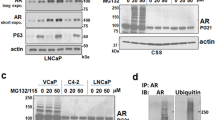Abstract
Androgen receptor (AR) is a ligand-controlled transcription factor that is deregulated and therefore targeted in prostate cancer. In addition to androgens, AR is regulated by post-translational modifications (PTMs). SUMOylation, conjugation of small ubiquitin-related modifier (SUMO) protein 1, 2, or 3, is a bulky PTM regulating several important physiological processes. We have shown that AR is modified by SUMO-1 at two conserved lysine residues in its N-terminal domain. This agonist-enhanced modification represses the transcriptional activity of the receptor in a reversible and target gene-selective fashion. Acceptor sites for SUMOs are also found in several other nuclear receptors. Since the cellular steady-state level of SUMO modifications of most substrates, including AR, is very low, transfection- and SUMO overexpression-based protocols are often needed to render the modifications clearly detectable. This chapter describes protocols for analyzing AR SUMOylation in cultured cells by immunoblotting, gel mobility shift assays, and immunoprecipitation. These methodologies are generally applicable for determining whether a particular protein is SUMOylated and for identifying the lysine residue(s) modified.
Access this chapter
Tax calculation will be finalised at checkout
Purchases are for personal use only
Similar content being viewed by others
References
Gao W, Bohl CE, Dalton JT (2005) Chemistry and structural biology of androgen receptor. Chem Rev 105: 3352–3370
Heemers HV, Tindall DJ (2007) Androgen receptor (AR) coregulators: a diversity of functions converging on and regulating the AR transcriptional complex. Endocr Rev 28:778–808
Knudsen KE, Scher HI (2009) Starving the addiction: new opportunities for durable suppression of AR signaling in prostate cancer. Clin Cancer Res 15:4792–4798
Hay RT (2005) SUMO: a history of modification. Mol Cell 18:1–12
Geiss-Friedlander R, Melchior F (2007) Concepts in sumoylation: a decade on. Nat Rev Mol Cell Biol 8:947–956
Rytinki M, Kaikkonen S, Pehkonen P, Jääskeläinen T, Palvimo JJ (2009) PIAS proteins: pleiotropic interactors associated with SUMO. Cell Mol Life Sci 66: 3029–3041
Hay RT (2007) SUMO-specific proteases: a twist in the tail. Trends Cell Biol 17:370–376
Poukka H, Karvonen U, Jänne OA, Palvimo JJ (2000) Covalent modification of the androgen receptor by small ubiquitin-like modifier 1 (SUMO-1). Proc Natl Acad Sci USA 97:14145–14150
Kaikkonen S, Jääskeläinen T, Karvonen U, Rytinki M, Makkonen H, Gioeli D, Paschal BM, Palvimo JJ (2009) SUMO-specific protease 1 (SENP1) reverses the hormone-augmented SUMOylation of androgen receptor and modulates gene responses in prostate cancer cells. Mol Endocrinol 23: 292–307
Owerbach D, McKay EM, Yeh ET, Gabbay KH, Bohren KM (2005) A proline-90 residue unique to SUMO-4 prevents maturation and sumoylation. Biochem Biophys Res Commun 337:517–520
Rytinki MM, Palvimo JJ (2009) SUMOylation attenuates the function of PGC-1α. J Biol Chem 284:26184–26193
Acknowledgments
This work was supported by Academy of Finland, Finnish Cancer Organisations, Sigrid Jusélius Foundation. We thank Dr. D. Owerbach for SUMO constructs.
Author information
Authors and Affiliations
Corresponding author
Editor information
Editors and Affiliations
Rights and permissions
Copyright information
© 2011 Springer Science+Business Media, LLC
About this protocol
Cite this protocol
Rytinki, M.M., Kaikkonen, S., Sutinen, P., Palvimo, J.J. (2011). Analysis of Androgen Receptor SUMOylation. In: Saatcioglu, F. (eds) Androgen Action. Methods in Molecular Biology, vol 776. Humana Press. https://doi.org/10.1007/978-1-61779-243-4_12
Download citation
DOI: https://doi.org/10.1007/978-1-61779-243-4_12
Published:
Publisher Name: Humana Press
Print ISBN: 978-1-61779-242-7
Online ISBN: 978-1-61779-243-4
eBook Packages: Springer Protocols




